How to use the transient keyword to control serialization in Java
1. Overview
For transient-modified member variables, they will be ignored during the serialization process of the instance object of the class. Therefore, transient variables will not run through the serialization and deserialization of the object. The life cycle only exists in the caller's memory and will not be written to disk for persistence.
1. Serialization
Serialization of objects in Java refers to converting objects into representations in the form of byte sequences. These byte sequences contain the data and information of the object. A serialized object can be written to a database or file, or used for network transmission. Generally, when we use cache (if there is not enough memory space, it may be stored locally on the hard disk) or remotely call rpc (network transmission), we often need to make the entity class implement the Serializable interface in order to make it serializable. Of course, the ultimate goal after serialization is to deserialize and restore it to the original Java object instance. Therefore, the serialized byte sequence can be restored into a Java object. This process is deserialization.
2. Why use the transient keyword?
When persisting objects, we do not want to use the serialization mechanism to save some special data members (such as user passwords, bank card numbers, etc.). To turn off serialization on a member variable of a specific object, you can add the keyword transient before the member variable.
3. The role of transient
Transient is a keyword in the Java language, used to indicate that a member variable is not part of the serialization of the object. When an object is serialized, the values of transient variables are not included in the serialization result. Non-transient variables are included. Note that static variables modified by static are naturally not serializable.
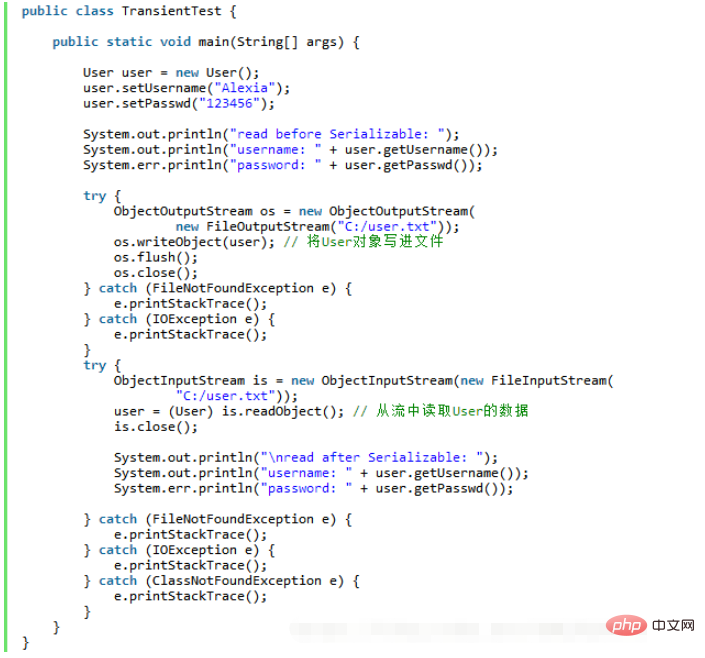
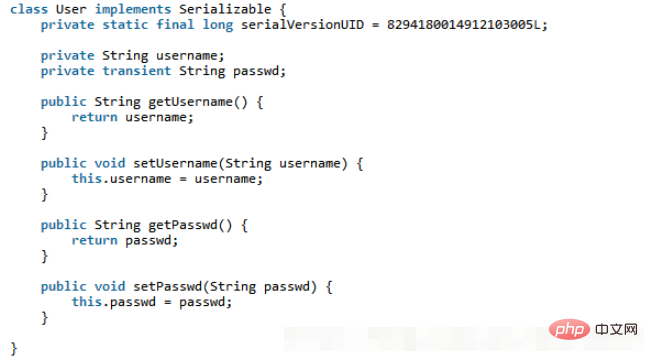
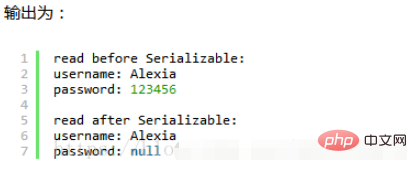
2. Summary of transient usage
(1) Once the variable is With transient modification, the variable will no longer be part of the object's persistence, and the content of the variable cannot be accessed after serialization.
(2) The transient keyword can only modify variables, but not methods and classes. Note that local variables cannot be modified by the transient keyword. If the variable is a user-defined class variable, the class needs to implement the Serializable interface.
(3) A static variable cannot be serialized regardless of whether it is modified by transient (if the static variable in the class still has a value after deserialization, the value will be the value of the corresponding static variable in the current JVM). Serialization saves object state, and static variables save class state, so serialization does not save static variables.
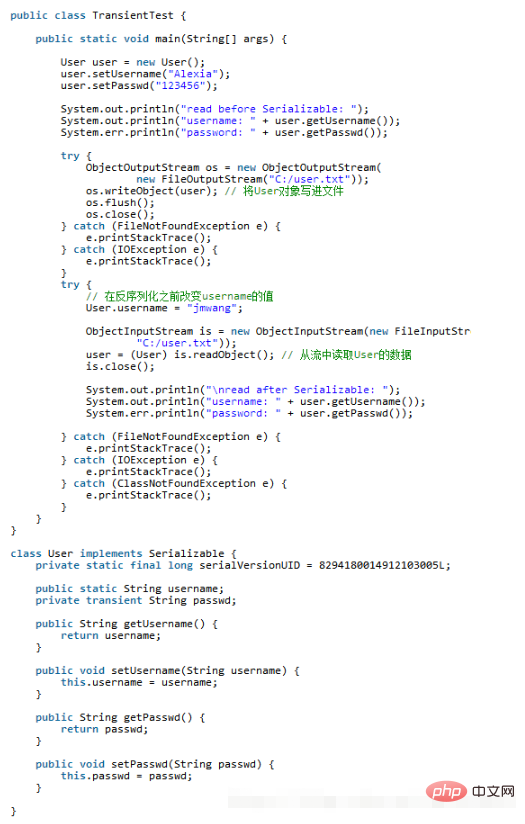
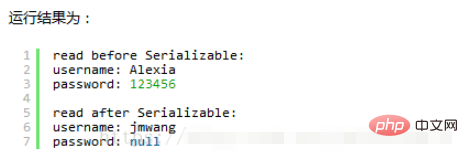
3. Usage scenarios
(1) Field values in the class can be derived based on other fields, such as A rectangle class has three attributes: length, width, and area. The area does not need to be serialized.
(2) Some security information cannot leave the JVM under normal circumstances.
(3) If a Logger instance is used in the class, the Logger instance does not need to be serialized
The above is the detailed content of How to use the transient keyword to control serialization in Java. For more information, please follow other related articles on the PHP Chinese website!

Hot AI Tools

Undresser.AI Undress
AI-powered app for creating realistic nude photos

AI Clothes Remover
Online AI tool for removing clothes from photos.

Undress AI Tool
Undress images for free

Clothoff.io
AI clothes remover

Video Face Swap
Swap faces in any video effortlessly with our completely free AI face swap tool!

Hot Article

Hot Tools

Notepad++7.3.1
Easy-to-use and free code editor

SublimeText3 Chinese version
Chinese version, very easy to use

Zend Studio 13.0.1
Powerful PHP integrated development environment

Dreamweaver CS6
Visual web development tools

SublimeText3 Mac version
God-level code editing software (SublimeText3)

Hot Topics
 1386
1386
 52
52
 Perfect Number in Java
Aug 30, 2024 pm 04:28 PM
Perfect Number in Java
Aug 30, 2024 pm 04:28 PM
Guide to Perfect Number in Java. Here we discuss the Definition, How to check Perfect number in Java?, examples with code implementation.
 Weka in Java
Aug 30, 2024 pm 04:28 PM
Weka in Java
Aug 30, 2024 pm 04:28 PM
Guide to Weka in Java. Here we discuss the Introduction, how to use weka java, the type of platform, and advantages with examples.
 Smith Number in Java
Aug 30, 2024 pm 04:28 PM
Smith Number in Java
Aug 30, 2024 pm 04:28 PM
Guide to Smith Number in Java. Here we discuss the Definition, How to check smith number in Java? example with code implementation.
 Java Spring Interview Questions
Aug 30, 2024 pm 04:29 PM
Java Spring Interview Questions
Aug 30, 2024 pm 04:29 PM
In this article, we have kept the most asked Java Spring Interview Questions with their detailed answers. So that you can crack the interview.
 Break or return from Java 8 stream forEach?
Feb 07, 2025 pm 12:09 PM
Break or return from Java 8 stream forEach?
Feb 07, 2025 pm 12:09 PM
Java 8 introduces the Stream API, providing a powerful and expressive way to process data collections. However, a common question when using Stream is: How to break or return from a forEach operation? Traditional loops allow for early interruption or return, but Stream's forEach method does not directly support this method. This article will explain the reasons and explore alternative methods for implementing premature termination in Stream processing systems. Further reading: Java Stream API improvements Understand Stream forEach The forEach method is a terminal operation that performs one operation on each element in the Stream. Its design intention is
 TimeStamp to Date in Java
Aug 30, 2024 pm 04:28 PM
TimeStamp to Date in Java
Aug 30, 2024 pm 04:28 PM
Guide to TimeStamp to Date in Java. Here we also discuss the introduction and how to convert timestamp to date in java along with examples.
 Java Program to Find the Volume of Capsule
Feb 07, 2025 am 11:37 AM
Java Program to Find the Volume of Capsule
Feb 07, 2025 am 11:37 AM
Capsules are three-dimensional geometric figures, composed of a cylinder and a hemisphere at both ends. The volume of the capsule can be calculated by adding the volume of the cylinder and the volume of the hemisphere at both ends. This tutorial will discuss how to calculate the volume of a given capsule in Java using different methods. Capsule volume formula The formula for capsule volume is as follows: Capsule volume = Cylindrical volume Volume Two hemisphere volume in, r: The radius of the hemisphere. h: The height of the cylinder (excluding the hemisphere). Example 1 enter Radius = 5 units Height = 10 units Output Volume = 1570.8 cubic units explain Calculate volume using formula: Volume = π × r2 × h (4
 Create the Future: Java Programming for Absolute Beginners
Oct 13, 2024 pm 01:32 PM
Create the Future: Java Programming for Absolute Beginners
Oct 13, 2024 pm 01:32 PM
Java is a popular programming language that can be learned by both beginners and experienced developers. This tutorial starts with basic concepts and progresses through advanced topics. After installing the Java Development Kit, you can practice programming by creating a simple "Hello, World!" program. After you understand the code, use the command prompt to compile and run the program, and "Hello, World!" will be output on the console. Learning Java starts your programming journey, and as your mastery deepens, you can create more complex applications.




